
| Home | Deepsky Atlas | TheAstronews | Links | Solar System | ||||||

Hawaiian Astronomical SocietyConstellations: Cassiopeia -- Mother of Andromeda |
||||||||||
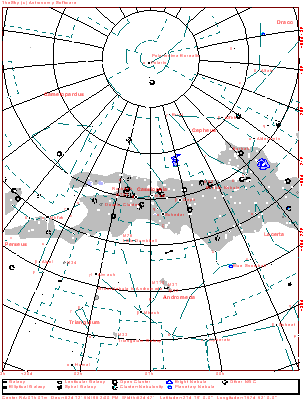
Click the map for a 909x1199 version of the above. Click here for a map better suited for use in the field.
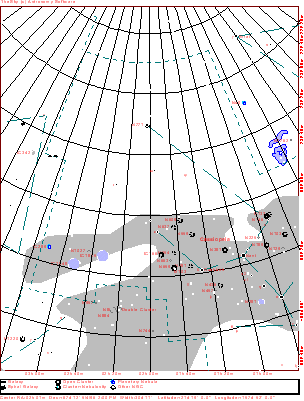
Click here for a map better suited for use in the field.
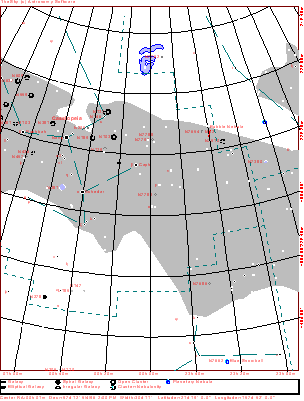
Click here for a map better suited for use in the field.
 89k JPEG Stock 12 is a loose open cluster located in the far SW of the constellation. Its size is listed as 20', and it contains stars mag 8 and fainter. You find it on the bottom end (south) of the image, 2/3 to the left (east). Frankly, it's boring. The good stuff is a splash of muticolored stars 30' to the NW. From the Digital Sky Survey. 89k JPEG Stock 12 is a loose open cluster located in the far SW of the constellation. Its size is listed as 20', and it contains stars mag 8 and fainter. You find it on the bottom end (south) of the image, 2/3 to the left (east). Frankly, it's boring. The good stuff is a splash of muticolored stars 30' to the NW. From the Digital Sky Survey.
|
|
Image on the left from the Digital Sky Survey. Color image on the right by Beat Kohler and posted on Astro Info, a service of the Swiss Astronomical Society. A multilingual web site, most of the information is available only in German.
|
 32k JPEG M52 (NGC7654) is a large (13'), condensed, rich open cluster on the western border of Cassiopeia. Total brightness is mag. 6.9. Stars range from mags. 9-13. Messier thought he saw nebulosity, but there is none. Image taken with a HISYS 22 on a 4" Meade at f6.3. 32k JPEG M52 (NGC7654) is a large (13'), condensed, rich open cluster on the western border of Cassiopeia. Total brightness is mag. 6.9. Stars range from mags. 9-13. Messier thought he saw nebulosity, but there is none. Image taken with a HISYS 22 on a 4" Meade at f6.3.
|
|
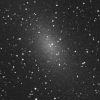 24k JPEG NGC147 (Caldwell 17) is a very faint (mag. 9.3), very large (13'x8'), irregular shaped dwarf elliptical galaxy with a bright core accented by foreground stars at the core. It is located 5.4° south of Zeta Cassiopeiae. From the Digital Sky Survey. 24k JPEG NGC147 (Caldwell 17) is a very faint (mag. 9.3), very large (13'x8'), irregular shaped dwarf elliptical galaxy with a bright core accented by foreground stars at the core. It is located 5.4° south of Zeta Cassiopeiae. From the Digital Sky Survey.
|
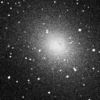 11k JPEG NGC185 (Best 12, Caldwell 18) is a pretty bright (mag. 9.2), very large (14'x12'), irregular shaped dwarf elliptical galaxy with a less pronounced core than its companion NGC147. Dreyer says it is "resolvable," meaning there are dark markings in the middle. It is located 5.4° south of zeta Cassiopeiae. From the Digital Sky Survey. 11k JPEG NGC185 (Best 12, Caldwell 18) is a pretty bright (mag. 9.2), very large (14'x12'), irregular shaped dwarf elliptical galaxy with a less pronounced core than its companion NGC147. Dreyer says it is "resolvable," meaning there are dark markings in the middle. It is located 5.4° south of zeta Cassiopeiae. From the Digital Sky Survey.
|
 64k JPEG NGC281 (Best 13) is an open cluster with nebulosity located 1.7° east of Shedar (Alpha Cassiopeiae). Dreyer's description reads as follows: Faint (mag. 7), very large (35'), diffused, with a small triple star on the northwest edge. The nebulosity, sometimes called the Pacman Nebula, responds to filters, and even better to photography. It lies in a rich field. Image by Marco Lorenzi taken on film through an 8", f4, coma corrected Newtonian. 64k JPEG NGC281 (Best 13) is an open cluster with nebulosity located 1.7° east of Shedar (Alpha Cassiopeiae). Dreyer's description reads as follows: Faint (mag. 7), very large (35'), diffused, with a small triple star on the northwest edge. The nebulosity, sometimes called the Pacman Nebula, responds to filters, and even better to photography. It lies in a rich field. Image by Marco Lorenzi taken on film through an 8", f4, coma corrected Newtonian.
|
 47k JPEG Object 4 (Be4) in the Berkeley University Catalog of open clusters. This is a mag 10.6 grouping with members at mags 12.5 and fainter. Size is about 5'. A notable feature is the tight, arrow shaped cluster pointing south, and an arc of stars to the ESE. Located 2° NE of Kappa Cassiopeiae. From the Digital Sky Survey. 47k JPEG Object 4 (Be4) in the Berkeley University Catalog of open clusters. This is a mag 10.6 grouping with members at mags 12.5 and fainter. Size is about 5'. A notable feature is the tight, arrow shaped cluster pointing south, and an arc of stars to the ESE. Located 2° NE of Kappa Cassiopeiae. From the Digital Sky Survey.
|
 71k JPEG IC59 and IC63 are parts of a reflection nebula located .5° north and north-east of Navi (Gamma Cassiopeiae. Both are fairly faint and extremely large. Dreyer's little "remarkable" code sits after the size description, rather unusual. The photograph from the Digital Sky Survey suggests you may have better luck with IC63. The plates are somewhat blue sensitive, though. Also, while you fit everything in a 1° field, you will do better keeping Navi out of the field. 71k JPEG IC59 and IC63 are parts of a reflection nebula located .5° north and north-east of Navi (Gamma Cassiopeiae. Both are fairly faint and extremely large. Dreyer's little "remarkable" code sits after the size description, rather unusual. The photograph from the Digital Sky Survey suggests you may have better luck with IC63. The plates are somewhat blue sensitive, though. Also, while you fit everything in a 1° field, you will do better keeping Navi out of the field.
|
 6k GIF NGC457 (Best 14, Caldwell 13) is a bright (mag. 6.4), large (13'), pretty rich cluster with stars from mag. 8 and fainter. Called the Owl Cluster, it is located 2.1° SSW of Ruchbah (Delta Cassiopeiae). The image is a drawing by Peter Schlatter of observations through a 10" Schmidt-Cassegrain telescope at 62x on August 31, 1995. 6k GIF NGC457 (Best 14, Caldwell 13) is a bright (mag. 6.4), large (13'), pretty rich cluster with stars from mag. 8 and fainter. Called the Owl Cluster, it is located 2.1° SSW of Ruchbah (Delta Cassiopeiae). The image is a drawing by Peter Schlatter of observations through a 10" Schmidt-Cassegrain telescope at 62x on August 31, 1995.
|
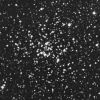 34k JPEG NGC559 (Caldwell 8) is an open cluster located 2.8° west of Epsilon Cassiopeiae. Dreyer calls it bright (mag. 9.5), pretty large (4'), and pretty rich. It contains about 60 stars, mag. 10.6 and fainter. From the Digital Sky Survey. 34k JPEG NGC559 (Caldwell 8) is an open cluster located 2.8° west of Epsilon Cassiopeiae. Dreyer calls it bright (mag. 9.5), pretty large (4'), and pretty rich. It contains about 60 stars, mag. 10.6 and fainter. From the Digital Sky Survey.
|
 32k JPEG M103 (NGC581) is a pretty large (6'), round, rich open cluster 1° NW of Delta Cassiopeiae. Total brightness is mag. 7.4. Stars range from mags. 10-11. Image taken with a HISYS 22 (two minute exposure) on a 4" Meade at f6.3. 32k JPEG M103 (NGC581) is a pretty large (6'), round, rich open cluster 1° NW of Delta Cassiopeiae. Total brightness is mag. 7.4. Stars range from mags. 10-11. Image taken with a HISYS 22 (two minute exposure) on a 4" Meade at f6.3.
|
 65k JPEG NGC663 (Best 15, Caldwell 10) is another open cluster located 2.4° SSW of Epsilon Cassiopeiae. Dreyer calls it bright (mag. 7.1), large (16'), and extremely rich. It contains about 80 stars, mag. 8.4 and fainter. Several of the brighter stars make pretty pairs. From the Digital Sky Survey. 65k JPEG NGC663 (Best 15, Caldwell 10) is another open cluster located 2.4° SSW of Epsilon Cassiopeiae. Dreyer calls it bright (mag. 7.1), large (16'), and extremely rich. It contains about 80 stars, mag. 8.4 and fainter. Several of the brighter stars make pretty pairs. From the Digital Sky Survey.
|
 79k JPEG Collinder 463 is a pretty open cluster, nice in moderately sized scopes, gorgeous in 16" and larger. Located in the far north of the constellation, its overall magnitude is 5.7, with individual stars at 8.5 and fainter. About 40 stars in a 36' field. From the Digital Sky Survey. 79k JPEG Collinder 463 is a pretty open cluster, nice in moderately sized scopes, gorgeous in 16" and larger. Located in the far north of the constellation, its overall magnitude is 5.7, with individual stars at 8.5 and fainter. About 40 stars in a 36' field. From the Digital Sky Survey.
|
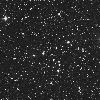 23k JPEG NGC743 is another open cluster located 4.2° east of Ruchbah (Delta Cassiopeiae). It's not rich and has a double star involved. It contains about 12 stars, mag. 10 and fainter. Shaped like "an arrowhead with a jewel inside it." From the Digital Sky Survey. 23k JPEG NGC743 is another open cluster located 4.2° east of Ruchbah (Delta Cassiopeiae). It's not rich and has a double star involved. It contains about 12 stars, mag. 10 and fainter. Shaped like "an arrowhead with a jewel inside it." From the Digital Sky Survey.
|
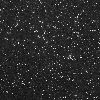 23k JPEG Stock 2 is an open cluster located 2° NNW of the Double Cluster in Perseus. This is a large cluster, one degree across, containing 50 stars, mag. 8.2 and fainter. A very nice binocular object. From the Digital Sky Survey. 23k JPEG Stock 2 is an open cluster located 2° NNW of the Double Cluster in Perseus. This is a large cluster, one degree across, containing 50 stars, mag. 8.2 and fainter. A very nice binocular object. From the Digital Sky Survey.
|
If you have any questions about the Hawaiian Astronomical Society
please
(link requires javascript).